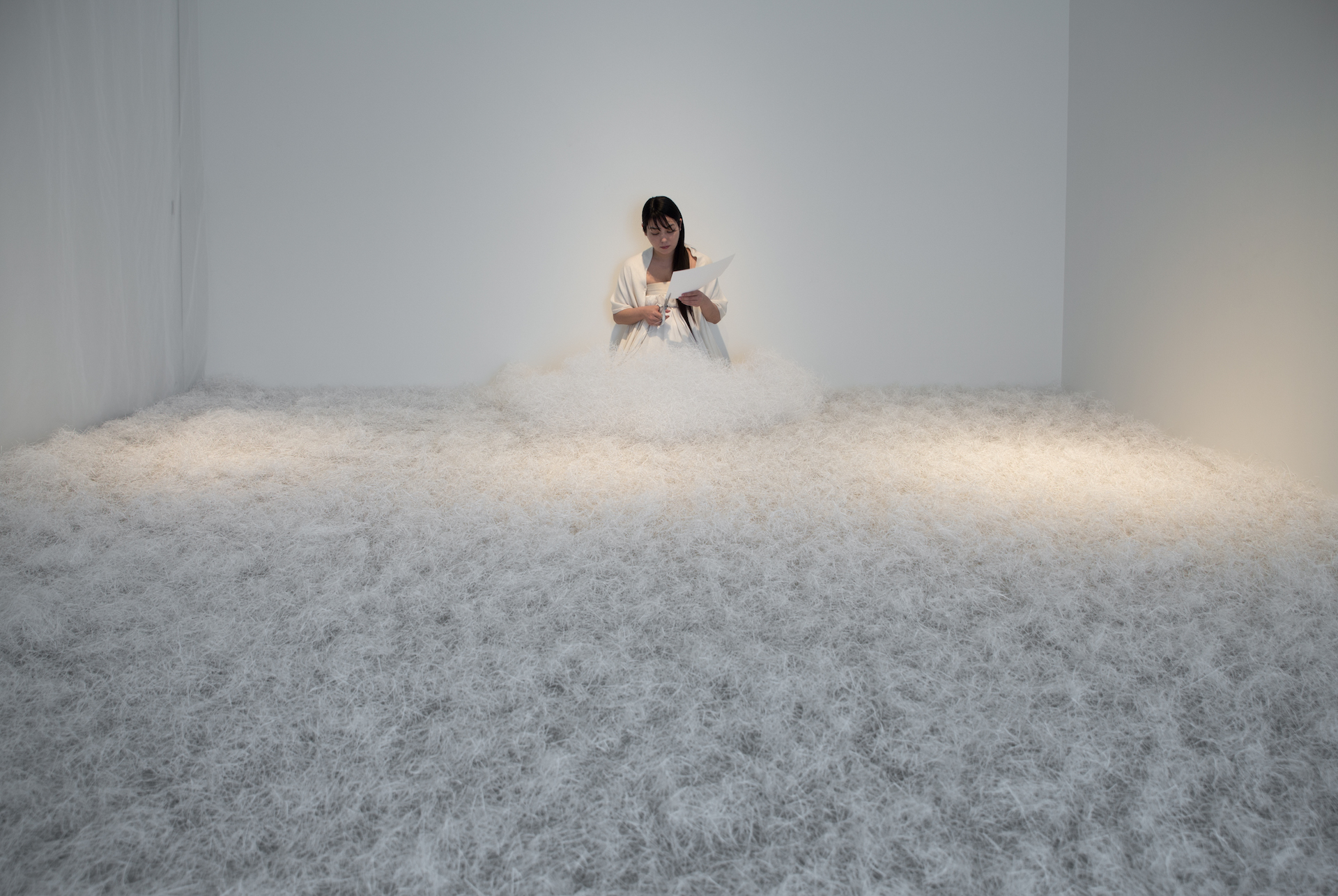タイトル:春を待ちながら-やがて色づく風景をもとめて-
時期:2015年2月28日~4月5日
場所:十和田市現代美術館
アーティスト:阿部幸子 / 高田安規子・政子 / 野村和弘
主催:十和田市現代美術館
Waiting for spring‐Towards a landscape changing color‐
February 28 – April 5, 2015
Venue:Towada Art Center
Artists:Sachiko Abe /Akiko & Masako Takada / Kazuhiro Nomura
Organized by:Towada Art Center
この地から、変わる、を考えはじめるために。
冬の十和田は、寒さが厳しい。
雪をたくさん積んでくる雲は、八甲田の山々にあたって雪を降り下ろし、風と残りの雪をこの地に届ける。そうした地で、冬から木々が芽吹く春にかけて「春を待ちながら」展は開かれた。これは、繰り返される営みによって、目の前に広がる風景が変わるということについて、この地方特有の風土と阿部幸子、高田安規子・政子、野村和弘の作品行為を重ね合わせ、鑑賞者と分かち合う試みであったといってもいい。
冬、特に日が落ちると、まちや通りに人影がほとんどなくなり、すべてが止まっているかのように見えることがある。ところがそれも、4月に入ると陽が柔らかくなり、春の兆しを感じ取れるようになる。少し思いを巡らせば、たとえ吹雪の日でも氷点下二十度にならんとする日でも、冬がゆるむ時に向けて、山川草木は止むことなく細胞を分裂させていることを知るだろう。少しずつ陽は伸び、雪で覆われていた土が顔を出す。彼方に見える白装束をまとったかのような八甲田の山々も、やがてそれを脱ぎはじめるときがやってくる。
人もまた、募る寒さに身の縮む思いをしながらも、己のあずかり知らぬところで絶えず細胞の入れ替えをし、生を営んでゆく。またそうした人と風土のあり方に呼応するかのように、繰り返す行為が生む生活文化がある。「刺し子」が、それだ。外に出られぬ日々、強度と保温をより確かなものにするため、布目に規則的に糸を刺してゆく。一刺しは、どれ一つとして同じではなく、移ろいゆく季節や天候、気温、そしてそれに反応する体の状態の表れとなりながら、秩序ある図柄を生み出してゆく。よく、この地を含め、東北の人は、厳しい自然に向き合うからか、我慢強いといわれるが、ただじっとしているわけではなく、変わってゆくことの先ぶれがそこにはある。
「春を待ちながら」展に参加した作家、阿部幸子の作品の一つに、≪Cut Papers≫がある。鋏を使い、比較的どこででも手に入るゼロックスのコピー用紙の端を、細く切り落としてゆくパフォーマンス作品だ。それを、一回に80分、多い日にはそれを三回、展覧会の会期中毎日行った。鑑賞者が展示室に入ると、真白いドレスに身を包んだ阿部が、部屋の一番奥にこちらを向いて座り、紙を切っている。行為は一見淡々と続いてゆくようであるが、呼吸や感情、それに立ち会う人の気配によって、微妙に手元のリズムと鋏の生む音が変わる。その空間はまるで、言葉を介さない会話で満たされているようだ。そして、一日一日と春に近づき雪が消えてゆくにつれ、展示室は、冬を留めおかんと、真っ白い雪原のようになってゆく。
高田安規子・政子は、いずれも彼女たち自身の連続する行為とそれが生む造形物や写真によって、世界の構造や成り立ちの不可思議に私たちの想像力を誘う。例えば、≪円形競技場≫では、市販されている軽石を素材に、ローマにあるコロッセオ(円形競技場)を象ったものだ。琺瑯ほうろうの洗面器に入れられ、まるで本物が縮小したかのような円形競技場がある。そのオブジェの周りに残されている石粉は、彫刻の作業がいま終わったかのような、二人の行為の跡を瑞々しく伝えることだろう。また、ローマの円形競技場も、この≪円形競技場≫も、素材は同じ石だが、意図的に脆く、小さい軽石を使うことによって、日常にあるものの経年による劣化と栄華を誇ったローマ帝国の衰亡を重ね合わせていることも忘れてはならない。
そして、野村和弘の≪笑う祭壇≫は、鑑賞者が、使い古されたボタンを、目の前の仕切られた場に置かれた小さな二つの的をめがけて投げ、乗せることを目的としたある種のゲームを組み込んだインスタレーション作品だ。ボタンを手に取り、投げ入れる。すると、それは、うまくいっても的にぶつかりはするものの、そこから逸れてあらぬ方向へと転がってゆくだろう。そうして、散らばるボタンの色や図柄は刻々と変わりゆくのを見ると、投げ入れられるボタンは、持ち主の気配をかすかに宿しつつも、床に広がった抽象的な絵画を生み出している筆のタッチのように見えてくる。そうして、目的はなかなか果たされないまま、無邪気な遊びはつづき、匿名の絵画的な風景は生み出されてゆく。
繰り返しの行為や運動は、それを誘発する力やそれによって現れる形に微妙な違いを生みながら、やがて今まで見たことのない状況へ私たちを導いてゆくことだろう。「繰り返し」という凡庸な言葉のなかには、営みや行為の間に生まれる「違い」がすでに折り込まれている。そうした「違い」の積み重なりによって、季節や風景は変わってゆく。この地には、繰り返しを経て巡る自然と文化の営みがある。それは、じっと耐え忍ぶといわれる東北の人々の気質を乗り越えて、自然の風景や政治的な状況の変化を呼び起こす力となってゆくことを想像せずにはいられない。誰に何を言われなくとも、やがて風景は変わってゆく。そうしたこの土地に潜む力に気づいたとき、この地は、そして東北は、私たちが見知らぬものとして現れ、春が謳われることだろう。
小澤慶介(十和田市現代美術館チーフ・キュレーター)
In order to begin thinking of change from this land
The Towada winter is brutally cold.
Heavy clouds coat the Hakkoda mountains with snow, bringing wind and what snow remains to the land here. And just as the trees began to put forth buds after surviving the winter, we held an exhibition, “Waiting for spring – Towards a landscape changing color.” Superimposing the artworks of Kazuhiro Nomura, Akiko & Masako Takada, and Sachiko Abe over the unique climate of the region, we might call it an attempt to share with visitors how the act of repeating may cause changes in the landscape before our eyes.
In winter, dusk comes and the streets are empty; things seem to stop. But come April, the sun grows softer and you can sense the signs of spring. To mull this further: even on days with blizzards or days when it’s 20 below, you know that, as winter passes, nature will ceaselessly tear cells apart. The days grow longer, little by little; the ground covered by snow starts to show its face. As if camouflaged in white shrouds in the distance, the Hakkoda mountains too eventually begin to shed their snowy clothing.
People too, even while shivering in the cold, constantly renew their cells in places they know nothing of, creating new life. Moreover, a lifestyle culture is produced by these repeated acts, as if responding to the people and the climate. Sashiko stitching is just like this. On those days when you cannot go outside, you stitch thread into cloth in order to enhance the strength or heat-retention of the materials. A single stitch is never the same as another, manifesting the changing seasons, the weather and temperature, and the state of the body in response to this, gradually producing an ordered pattern. Tohoku people, including from this area, are often praised for their endurance in the face of this harsh nature. However, this is actually a portent of how they are not standing still, but rather forever changing.
One of the artworks featured in the exhibition was a work by Sachiko Abe, Cut Papers. It is a performance art piece by Abe, in which she uses scissors to cut Xerox photocopier paper up into thin strips. Abe performed this for 80-minute sessions, which she conducted every day of the exhibition period, sometimes three sessions per day. When the visitor enters the exhibition room, Abe is sitting down at the end of the room facing them, wearing a bright white dress and engaged in cutting paper. While her actions appear indifferent, the rhythm of the cutting and the sound produced by the scissors in her hands are subtly adjusted according to her breathing and emotions, and the behavior of the person facing her. It is as if the space is completely filled with a wordless conversation. Day by day, as spring approached, the snow began to melt and the exhibition room gradually transformed into a kind of snowfield, as if attempting to hold onto winter before it disappears.
Likewise through continued actions and the objects and photographs produced by these, Akiko & Masako Takada invite us to imagine the mysterious ways the world is constructed. For example, Colosseum uses commercial pumice stone to create a replica of the Roman amphitheater. Placed in an enamel washbowl, it looks like a miniature version of the actual Colosseum. The stone powder that remains around the sculpture freshly conveyed these traces of their actions, as if their carving work had only just now finished. Both the original Colosseum and this version use stone, and intentionally employing this brittle, small pumice stone emphasizes that the decline of the once glorious Roman Empire is superimposed over the deterioration of ordinary things through age.
In Kazuhiro Nomura’s installation Altar of Laughter, the viewer takes old buttons and tries to throw them so they balance on two targets placed before them like a game. The viewer picks up a button and then throws. Even if they are a good shot and manage to hit the target, it will surely still just bounce off it and roll away somewhere. As the colors and patterns of the buttons shift over time, the buttons become latent with the signs of ownership, while also taking on a form like brush touches on an abstract painting spread out on the floor. In this way, the innocent play continues without ever accomplishing its goal, instead creating an anonymous, pictorial landscape.
These repeated actions and movements produced subtle differences in the forces that provoked them or the forms arising from them, guiding us to situations we had never seen before. Concealed in the meaning of the banal word “repetition” is the idea of “difference” created between actions. As these differences accumulate, so the seasons and landscape change. This is a place where repetition is part of the workings of nature, people, and culture. This goes beyond the noted resilient character of Tohoku people. We cannot help but envision it rather as the power to evoke changes in the natural landscape and political climate. No matter what someone says, the landscape eventually changes. When we realize the latent power of this place, it, along with Tohoku as a whole, reappears as something unfamiliar, something advocating spring.
Keisuke Ozawa (Chief Curator, Towada Art Center)

